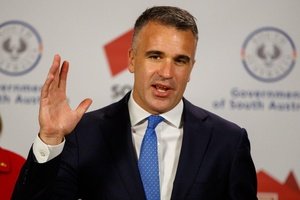A former school leader in the Catholic system, now education lecturer at the University of Melbourne, Dr Adam Taylor, has the answers.
He’s been delving into governance shifts in all non-government schools, with Catholic schools first cab off the rank.
Thanks to his sleuthing, 28 hours of interviews, and a freedom-of-information request, Taylor has found increasing complexity in the Catholic system and offers insights into the potential impacts.
A complex system
Currently, Australia has 77 separate governance structures for Catholic schools.
These are among the 860 approved authorities that govern non-government schools that currently exist in Australia. Most of these are standalone independent schools, with the number up from 816 just five years ago.
“Having so many separate governance arrangements for Catholic schools to operate in this country runs contrary to the common perception that Catholic schools are a single, homogenous educational sector," Taylor says.
“The structures include religious institute schools (RIs); relatively new legal entities called MPJPs (Ministerial Public Juridic Person), which are lay-led outgrowths of former RIs; and one or more diocesan offices in every state and territory which govern so-called systemic schools.
"Sometimes there are memoranda of understanding between RIs and MPJPs and diocesan offices and sometimes not. The number of arrangements is dazzling,” he adds.
“In the NSW Catholic school sector alone, there are 10 MPJPs operating with three or more schools. There are 10 religious institutes, with many of the latter governed at the school level.
“That’s 30 different governors in NSW alone.”
Taylor says government funds “tend to be channeled through to the diocesan systems”, which means that MPJP and RI schools “can get somewhat shortchanged”.
We’re talking about a lot of funds for this sector, too, which should attract wider attention, he says.
“Such a significant portion of the $29.1 billion that the federal government spends in education goes to non-government schools, and a third of funds go to Catholic schools.”
The invisible principal
According to Taylor’s previous research, the demands of a more complex governance affects principals most directly.
“When a school principal operated in a Catholic school maybe 20 years ago, if they wanted to, they could teach a least one class.
"But they can’t do that anymore because if they did, they’d be gone so many times attending to other matters, they’d be doing a dis-service to their students.
“So many principals have expressed the desire to be out and about amongst their staff and students as a highly present school leader, but that’s a romanticised image which is ancient history," he says.
Teachers may be “largely unaware” of these impacts of contemporary governance shifts.
“Principals are forced to manage the complexities of leading and managing which arise out of the ways in which their roles are being conceived by new governance demands," Taylor says.
"These increasing expectations around accountability, compliance, risk, and financial responsibilities all stem from these governance shifts, which are absolutely influenced by a move towards corporate governance models.
“The problem with corporate governance models is that they are largely developed for the for-profit sector.”
That means the boards of Catholic governance structures tend to seek experts in law, finance, strategy, information technology, communication, stakeholder engagement, for example.
Non-educators at the helm
What’s often missed is expertise in education leadership – a former principal that’s come up the ranks.
Taylor says boards are increasingly using “High Street recruiters, leading to a certain kind of governor”, particularly if it’s a paid position.
“Governance board members’ job is to have their eyes set on the horizon, planning for 10 years down the track, but frequently what’s reported back to me already is that they’re looking more short term, which compromises the leadership at management level.
"They’re getting involved in day-to-day organizational and management issues, and that’s inappropriate because it’s over reach.”
Taylor has found 43 per cent of the leaders in Catholic commissions and school systems are non-educators.
“They’re the approved system authorities that accept monies on behalf of the government and distribute it to schools, so they’re important players.
"If you calculated non-educators in leadership role by student numbers, the figure goes up to 46.3 per cent of the sector,” he says.
The proportion of non-educators in key roles at the pointy end of the Catholic school sector in Melbourne and Sydney gets even higher – all four executive directors come from a non-school-education professional background.
“There is a sense of a growing lack of confidence in the educational leaders as the experts best placed to lead school system,” Taylor points out.
From his interview across the Catholic sector a popular sentiment was “we are far better served with leaders who are strong Catholic educators”.
Taylor admits such leaders might require detailed legal knowledge, human resources, or financial expertise, but “that’s skill you can buy in”.
“You can’t buy in very easily a sense of vision and mission. That’s for me, really the heart of why it’s an issue. Catholic educators have in the marrow of their bones, a real clarity about what matters.
"It’s very rare in my experience to hear corporate-style leaders in Catholic education talking about young people.”
Instead, corporate leaders “talked a lot about money”, and have a steely focus on data.
“Often chairs are captains of industry and apply the same kind of rules and processes in school and system leadership as they do in for-profit companies. That’s problematic when there is not a balancing educational leader as the executive director or chief executive officer.”
Boardroom to classroom: A potential disconnect?
Taylor relays “stories from the trenches” about underperforming principals who face corporate style board who “Just suggest that the best approach would be to get rid of them”.
“The slash and burn approach of the corporate world doesn’t work in schools. If you turn over principals in a school rapidly, you create a culture of anxiety and uncertainty in the school among staff, students and the parent body. It’s a lack of respect for the expertise of the educator.”
Taylor says corporate dashboards look narrowly at school success.
“If you create confident young people who have a strong sense of agency about what they do in their world, you’ll create citizens who’ll have happy lives and make contributions to society. That covers a whole lot of jobs and roles that may not need an ATAR or university degree.
“How do you measure that confidence? Boards aren’t interested in that because you can’t put it on a dashboard.”
With principals under pressure with such narrow metrics, this “places pressure back on teachers to perform against those metrics”, he says.
“What you measure becomes important. This is about the Catholic sector moving closer to the narrow measure of what school life can and should be.”
The corporatisation also impacts teachers work though the risk lens, curtailing opportunities such as excursions and overseas trips.
Why Catholic governance is going corporate
Taylor says the influx of non-education leaders into the Catholic system was a reaction to the royal commission into religious institutions’ responses to child sexual abuse. It ran from 2013 and issued its final report in late 2017.
“However, the shift in leadership of Catholic schools had been changing for decades from nuns and brothers to lay people. Since bishops were called to the dock in the royal commission, there has been an over-reaction to what were the existing arrangements. We’ve seen really dramatic shifts in governance.”
The Gonski Review of school funding and the Global Financial Crisis have also contributed to the shift, he says.
Australia is unique in having such a large government-funded Catholic school sector, having so many young people educated in its schools, says Taylor.
He’s dubbed it “hetero-provisional governance” and says it “doesn’t exist in any other country and is very poorly understood”.
“It’s not all doom and gloom," Taylor says.
“These new leaders can bring fresh perspectives and valuable skills.
"The key is finding ways to bridge the gap, to leverage their expertise while ensuring a strong focus on the specific needs of Catholic education.”














